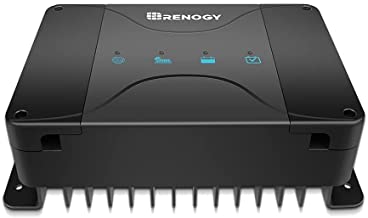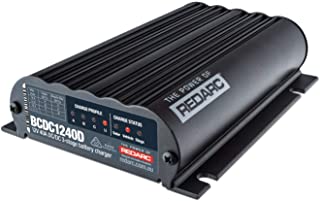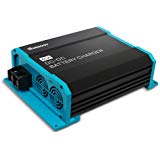User Tools
This is an old revision of the document!
Table of Contents
Battery to battery chargers
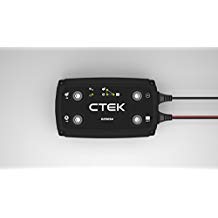 A b2b (or dc-dc) charger is a type of isolator that converts alternator voltage to specific voltage setpoints instead of just passing it through as a relay might.
A b2b (or dc-dc) charger is a type of isolator that converts alternator voltage to specific voltage setpoints instead of just passing it through as a relay might.
Because of their electronic nature they are limited to a rated amount of current1) which can protect your alternator from damage. This can be especially important with Lithium and AGM batteries that can demand huge loads from the alternator when discharged.2)
limitations
Charger throughput is generally limited to 20-30A3) since higher rates would dictate $$$ internal components, whereas plain isolators might pass as much current as the alternator, battery, and wiring could handle. This isn't as big a limitation as it might seem since lead-acid current acceptance drops substantially throughout Absorption, and lithium owners often limit charging to C/5 for maximal longevity.
Untested theory: b2b chargers might work well beside normal isolators; this is essentially the $$$ CTEK SmartPass setup described below.
In addition, even DC-DC chargers can fail to charge lead batteries fully. Lead-acid batteries require two things to get fully charged:
- a high enough Absorption voltage (Vabs) - DC-DC chargers handle this nicely.
- enough time at that voltage for the battery to stop accepting much current.4) If you aren't driving for (say) 5 hours then the charger can't charge for 5 hours to meet the battery's needs. 5) This is where a bit of solar helps with the long-duration duties.
DC-DC chargers are often triggered by the IGN circuit, but voltage sensing can be added to that circuit. Others are triggered by chassis-side voltage alone.
DC-DC chargers typically do not support self-jumpstarting, although the need for jumpstarting may be reduced with combo units (below) that maintain the starter battery from solar power.
Dual-input (alternator + solar) units make charging source decisions that are sometimes quirky. See below.
sizing
DC-DC chargers come in different ratings (10A, 40A, 60A, etc) which increase significantly in price as the rating increases.
Bigger is not always better, since battery types accept current at different rates and buying more charging capacity than the battery wants6) is a waste. Assuming a 100Ah battery:
- Flooded lead-acid accepts a maximum of about C/5, or 20A and requires a minimum of C/10 (10A). In this case, 10-20A of charging capacity would be appropriate. Less than 10A would be insufficient for battery health and more than 20A would be wasted expense.
- AGM lead-acid accepts a max of about C/3, or 33A per 100A of battery capacity, and requires a minimum of C/5 (20A). In this case, 20-33A of charging capacity would be appropriate. Less than 20A would be insufficient for battery health and more than 33A would be wasted expense.
- Lithium has very low internal resistance, and may be able to slurp up all the alternator has to give. However, for the following reasons an appropriate charging capacity for lithium would be as small as possible while still meeting your power needs:
- added expense
- lithium does not care about partial states of charge
- lithium tends to last longest with gentler charging/discharging
- the alternator will be happier with lighter loading
isolated chargers
Isolated DC-DC chargers have negative terminals output side (battery bank) “galvanically isolated” from the input side (alternator). It is not needed for most use cases:
Generally speaking, one only needs to isolate the negatives when the installation does not share a common negative return path, such as may be the case on many fiberglass boats that don't have a chassis and may not have a common grounding bus to which all their battery banks connect. – Justin Cook7)
But note that a trailer does not always have common grounding:
Galvanically isolated is a nice thing to have, especially if you are charging house batteries in a trailer from the tow vehicle engine. The issue relates to how the house battery is grounded to chassis ground when the tow vehicle is disconnected. All in one RVs and vans don't have this issue (probably) so I would not expect them to need galvanic isolation. (emphasis added) – HaldorEE8)
examples - combo with solar charge controller
Combining the solar charge controller and DC-DC charger in one unit can have benefits in cleaner/simpler installation, starter battery maintenance from solar, and perhaps cost over separate components. The downsides are less configurabilty9), single points of failure, and limited options on solar input.
Combo units typically have much lower maximum panel input voltages (as low as 23v) than a standalone charge controller would (60v - 150v). This limits the solar configuration in a few ways:
- serial panel arrangements are effectively ruled out
- higher-voltage panels (nominal 20v, 24v) are effectively ruled out
- even nominal 12v panels with high Voc may be problematic. Poly panels, with their typically-lower Vmp/Voc, may be especially useful with combo units.
CTEK D250 series
 The most common b2b charger with 'dwellers is the D250 series, all of which are 20A smart chargers with integrated MPPT:
The most common b2b charger with 'dwellers is the D250 series, all of which are 20A smart chargers with integrated MPPT:
- D250 (pre-2018, discontinued) - the original, Vabs == 14.4v, Vfloat == 13.6v.
- CTEK D250SA, a 20A solar/alt controller. Vabs selectable 14.4v and 14.7v. Vfloat 13.6v. Added support for smart alternators.
- D250SE which has 14.2 Vabs and 13.3 Vfloat for lithium settings.
House and starter batteries are combined when the starter battery holds >13.1v for 5 seconds.10) The batteries are isolated when the starter battery is “<12.8V, for 10 sec… or service battery voltage > starter battery voltage”.
The SmartPass accessory and 80A-120A (see below) of alternator-voltage charging to the D250's output when Vbatt is low enough that the alternator can still charge it directly. This combined charging11) will happen in the first half of Bulk mode. As house battery voltage rises to normal alternator voltage the smartpass can no longer contribute. At that point the 20A D250SA continues voltage-boosted charging to Absorption voltage.12)
The smartpass also adds self-jumpstarting.
- Smartpass 80 - original model. 80A + 20A = 100A.
- Smartpass 120. 120A + 20A = 140A.
- SmartPass 120S as above, but with support for smart alternators.
Note: the CTEK D250SA13) panel voltage (Vpanel) maximum is 23v.14) There are user reports that the unit is repairable after overvoltage or polarity damage.15),16)
The MPPT charger will charge the house battery at up to 20A. CTEK specifies 50-300W of panel, though the 23v Vmax limits the unit to [electrical:solar:panels#panel_voltage|nominal 12v panels]. Note: polycrystalline panels may be more useful here, as their Voc should be a bit lower than mono.
The D250-series trickle charges the starter battery from a solar panel at intervals of 3 seconds if the service battery is fully charged.17)
solar+alternator behavior
The 250-series will charge simultaneously from solar and alternator up to the 20A output limit. No details are given in the manual.
starter battery maintenance behavior
The D250SA trickle charges the starter battery from a solar panel at intervals of 3 seconds if the service battery is fully charged.18)
Renogy
- DCC50S 50A model with MPPT charging. MPPT input limited to 25v.19) - manual (pdf) Total output is limited to 50A from either independent source (see below).
Note: a 30A combo model is also available
solar+alternator behavior
This device's behavior regarding solar+alternator charging is widely misunderstood.
The 50A dual-input charger prefers to charge by solar if possible, up to 50A. If it cannot meet charging demands alone and the engine is running it will will charge up to 25A by solar and 25A by alternator:
charging examples
Using the above information and a theoretical scenario where we have 15A20) of solar charging available during the daytime, an alternator capable of delivering 50A, and a bank able to accept 50A of charging:
- driving at night: 50A alternator + 0A solar = 50A total charging
- parked in daytime: 0A alternator + 15A solar = 15A total charging
- driving in daytime: 25A alternator + 15A solar = 40A total charging
Behavior is the same for the 30A model (pdf) except 15A + 15A vs 25A + 25A above.
starter battery maintenance behavior
If the service battery is in float charge stage, the starting battery will be charged at the same time. The charging voltage is limited at 13.8V. The charging amperage is limited at 25A.21)
Kisae
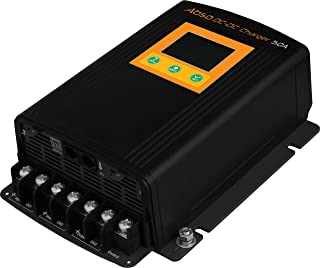 Kisae makes a DMT1230 DC-DC charger 30A charger with 50v MPPT input and 16v alternator input.22) They also make a 50A model (DMT1250), which charges up to 50A by alternator. Some sources give 50v as max input; check the current manual for your device. Both models list specifiy 500w of panel with up to 20% overpaneling (600w). The Kisae has a minimum solar input voltage of 14.5v.
Kisae makes a DMT1230 DC-DC charger 30A charger with 50v MPPT input and 16v alternator input.22) They also make a 50A model (DMT1250), which charges up to 50A by alternator. Some sources give 50v as max input; check the current manual for your device. Both models list specifiy 500w of panel with up to 20% overpaneling (600w). The Kisae has a minimum solar input voltage of 14.5v.
Customer support is generally regarded as excellent.
solar+alternator behavior
By default, when the alternator input terminals detect at least 13.2v the charger will be switched to alternator charging.23) The unit can be set to prefer solar charging instead.
starter battery maintenance behavior
The Kisae does not appear to maintain the starter battery.
Redarc
Redarc “dual input” DC-DC chargers have integrated MPPT controllers. They appear to do both buck and boost conversion as solar input voltage is 9v-32v.24)
solar+alternator behavior
starter battery maintenance behavior
These units do not appear to maintain the starter battery from solar. Redarc does document how to insert a switched relay in between the starter and aux batts to self-jumpstart.
Ring Automotive
Ring makes a 30A DC-DC charger with 50v max input MPPT. (manual)
Note: the Ring appears very similar to the Kisae (above).
examples - standalone
Sterling
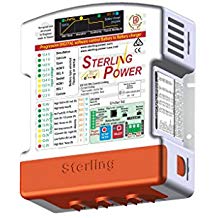 The Sterling Pro Batt Ultra series can be configured to exact setpoints. The BB1260-12 is a 30A example and costs about $50 more than the D250S above.
The Sterling Pro Batt Ultra series can be configured to exact setpoints. The BB1260-12 is a 30A example and costs about $50 more than the D250S above.
Renogy
- DC1212 series DC-DC isolators in 20-4027) output. Switched on by ignition circuit on the D+ port.28) DIP switches for battery type, Vabs and Vfloat. manual (pdf) teardown Note: some versions of the manual may have a typo.
Redarc
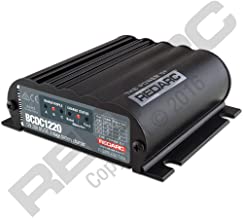 Redarc makes DC-DC chargers in 20A and 40A sizes.
Redarc makes DC-DC chargers in 20A and 40A sizes.
They have modes for “AGM, gel, calcium content, VRLA and standard lead acid batteries”.
Victron
Victron makes several DC-DC chargers, some of which are configurable by bluetooth. 12v examples:
- Orion-Tr 12|12-20 20A
See information on isolated v. non-isolated chargers above.
Bogart
Bogart's SC-2030 can work as a DC-DC charger as well as a PWM charge controller.
gotchas
Observe voltage input maximums on units with built-in solar charge controllers.
Voltage-sensing units29) can misbehave when an undersized starter battery charger/maintainer is attached. For this example we assume a 10A maintainer and a 20A DC-DC charger.
- starter battery voltage rises from 10A maintainer charging…
- triggering the DC-DC charger…
- which begins pulling up to 20A from the chassis
- pulling down the starter battery since the 10A maintainer cannot keep up
- starter battery voltage drops far enough the DC-DC turns off
- repeat forever
The workaround is to either charge the house battery first or to buy a big enough starter battery maintainer to support both the starter battery and DC-DC charger loads.
further reading
DC-DC charger (B2B) options and general discussion on DIY Solar Power Forum.

